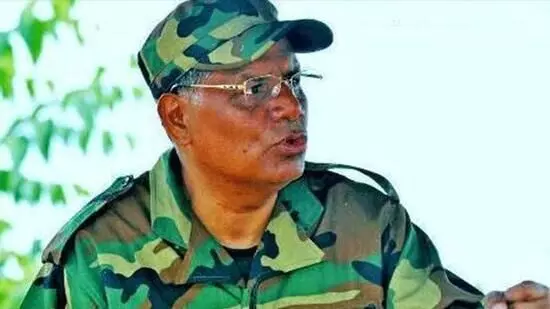Why ULFA(I) Repeatedly Lost Its Bases: A Military Analysis of Strategic Failures

The history of ULFA and ULFA(I), under Paresh Baruah, is marked by repeated military setbacks despite years of preparation, expenditure, and determination. At each critical base — Kachin, Lakhipathar, Bhutan, Bangladesh, and most recently Myanmar — ULFA’s strongholds were dismantled with precision. This report analyzes, from a military standpoint, why ULFA(I) failed to hold ground, even when tactically and logistically prepared.
🔷 The Kachin Misadventure (1988): Logistical Overreach and Poor Procurement
ULFA invested crores of rupees to establish a base in Kachin territory (Myanmar) to procure Chinese arms through the Kachin Independence Army (KIA).
Instead of modern weapons, ULFA received obsolete WWII-era rifles from 1942, a serious mismatch against Indian forces.
The KIA, under pressure and wary of Indian backlash, purged ULFA from its territory.
Military Missteps:
✅ Overestimated the KIA’s commitment to ULFA’s cause.
✅ Failed to secure reliable arms procurement channels.
✅ No contingency plan when the alliance soured.
🔷 Lakhipathar (1990): Tactical Weakness and Defensive Failure
Lakhipathar in Tinsukia was a natural base due to its terrain and proximity to Arunachal Pradesh. Yet ULFA could not defend it against the Indian Army.
The site lacked fortifications, escape routes, and defensive depth.
The Indian Army used superior coordination and firepower to capture the area swiftly.
Military Missteps:
✅ Poor defensive preparation.
✅ Underestimated Indian Army’s intelligence and ability to launch a coordinated offensive.
✅ Ignored principles of camouflage, mobility, and fallback positions.
🔷 Collapse in Assam (1992): Loss of Operational Depth
By 1992, ULFA officially admitted it could only maintain five cadres for its GHQ signaling a catastrophic collapse of its fighting strength.
The leadership had fled, leaving field units disorganized.
Many cadres surrendered (SULFA), depleting manpower.
Military Missteps:
✅ Inadequate command and control after leadership fled.
✅ Loss of morale and cohesion among rank and file.
✅ No structured guerrilla warfare doctrine to sustain operations under pressure.
🔷 Bhutan: Underestimating the Enemy (2003)
ULFA used Bhutan’s remote terrain for bases, assuming the monarchy would tolerate their presence.
Operation All Clear by Bhutan, supported by India, eliminated the camps.
ULFA failed to defend or re-establish positions after the offensive.
Military Missteps:
✅ Ignored Bhutan’s strategic alliance with India.
✅ Failed to build deep bunkers or fallback positions.
✅ Overconfidence and lack of intelligence about impending operations.
🔷 Bangladesh: Final Political and Military Collapse
ULFA found a haven in Bangladesh under a friendly regime. But after Sheikh Hasina’s government came to power, Dhaka coordinated with Delhi.
ULFA leaders were arrested or deported.
Large sums invested in safe houses, logistics, and networks were lost.
Military Missteps:
✅ No secure alternative routes or safe zones outside Bangladesh.
✅ Ignored signals of political change in Dhaka.
✅ Over-reliance on one host country for strategic depth.
🔷 Myanmar: The Last Stronghold Falls
Myanmar was ULFA(I)’s final sanctuary. Camps at Taka, Chen Hoyat, Namyun, Watkham were repeatedly targeted and destroyed in joint Indian–Myanmar operations.
Myanmar’s junta cooperated with India despite its own internal crises.
ULFA(I) could not defend even in rugged, remote areas.
Military Missteps:
✅ Failure to adapt to changing Myanmar–India relations.
✅ Poor intelligence on Indian infiltration capabilities.
✅ Underestimating the reach of modern surveillance and precision strikes.
⚔️ Why ULFA(I) Kept Losing: A Military Perspective
✅ Strategic Myopia — Chose bases based on immediate survival, not long-term defensibility.
✅ Geopolitical Ignorance — Failed to grasp India’s diplomatic influence over neighboring states.
✅ Lack of Tactical Innovation — Did not evolve guerrilla tactics to match India’s counter-insurgency advancements.
✅ Overconfidence in Terrain — Believed dense forests and hills alone would shield them without adequate fortifications or mobility.
✅ Underestimating Intelligence Warfare — India’s human and technical intelligence consistently outmaneuvered ULFA.
📝 Conclusion: The Collapse of a Dream
From Kachin to Myanmar, ULFA(I)’s story is a case study in how insurgent movements can be defeated by superior military strategy, intelligence, and diplomacy.
Bases were lost because they were not militarily sustainable, not deeply fortified, and not aligned with regional realities.
Paresh Baruah’s leadership failed to anticipate the enemy’s capabilities and alliances, resulting in repeated losses of men, material, and morale.
The final blows — in Myanmar’s Naga-administered zone — signal the collapse of ULFA’s military capacity and the death of its secessionist dream, marking a tragic but inevitable end to its armed struggle.
📌 Key Lesson:
No amount of money, weapons, or zeal can compensate for flawed military strategy and ignorance of the geopolitical chessboard.
